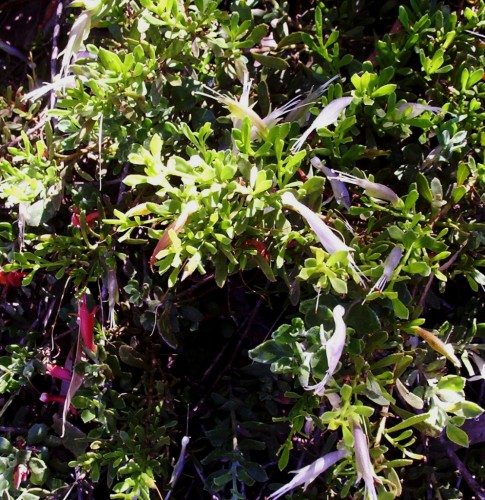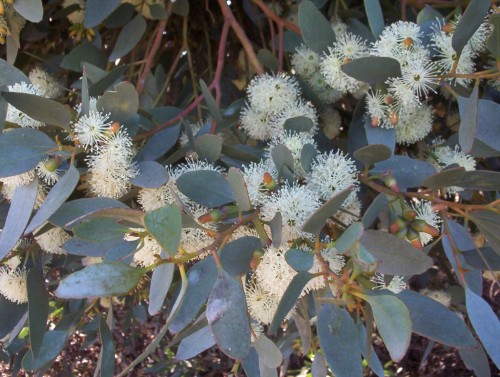Eremophila veneta (metallica) and Birds
Eremophila veneta is a hardy ground covering plant with silver and green flowers. It grows to about 15-30cm tall by 1-1.5m wide. It thrives in a dry, hot position with good drainage.
I am sure that the Shingle Back Lizards find the water in the bird bath which is on the ground in the same way. I have watched them walk quite a distance in a very purposeful manner, heading in a direct line for the dish.
More information can be found here.
Eremophilas (Emu Bushes) and Birds
The antics of the New Holland Honeyeater are amusing. There is a daisy bush growing beside this plant and it has light twiggy growth low down in the bush. The New Holland Honeyeaters hang by their claws like a trapeze artist to reach their beaks and long tongues into the flowers. Then they decide that it is just as easy to get at the nectar by hopping all over the plant as the other species do.
This particular plant has made roots along some stems and in doing so collects more moisture. The Eremophila glabra forms are all very hardy but like all plants appreciates water during mid summer. We had 33mm (about an inch and a quarter) rainfall last weekend and everything has perked up even though this rain was sopped up by the ground very quickly.
More information about Honeyeaters can be found at Trevor’s Birding.
Eucalyptus platypus (Moort)
Eucalyptus platypus is a Western Australian tree 4-10 metres high by 5-10 metres wide. It flowers from spring through to autumn, the flowers being creamy yellow as in the varieties growing around here, to greenish yellow. Apparently there is a red form also which is rare but would be beautiful given how floriferous this plant is.
This tree is fast growing and particularly suited to heavy soils. It tolerates some water logging and is hardy to drought and most frosts. It is highly resistant to smog. The trees respond well to pruning and coppicing. They have many uses including shelter belts and wind erosion control. The foliage grows low down on the plant giving the impression of a large shrubby tree. This aspect makes it a great plant for wind breaks. It is also a good plant for bee keepers.
Eucalyptus platypus (Moort)
It is named Eucalyptus platypus because the flower stem and buds resemble the foot and claws of this Australian Native animal.
Eucalyptus stricklandii (Yellow-flowered Blackbutt) And Birds
This also could be called ‘the perfect tree’. It is adaptable to many different soils including alkaline. It is ideal for arid and semi arid areas and warm temperate areas. Apparently it does not do so well in cold climates. It is useful for wind breaks and erosion control. The tree grows from 6-12 metres tall by 5-8 metres wide. Here it is the lower height. It is drought and frost hardy and resistant to smog. Flowering time is Spring through to Autumn.
This tree has been grown in Israel without irrigation and is also grown in California.
A good photo of a Puple-Crowned Lorikeet can can be seen on the site of The Australasian Bird Data Base.




